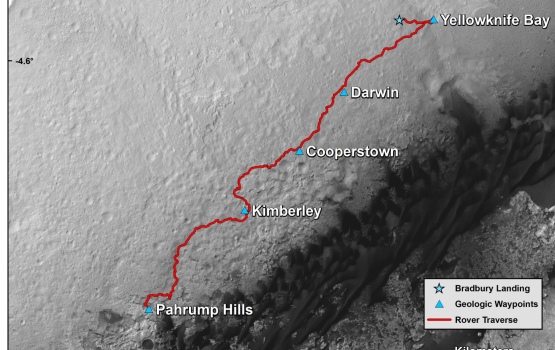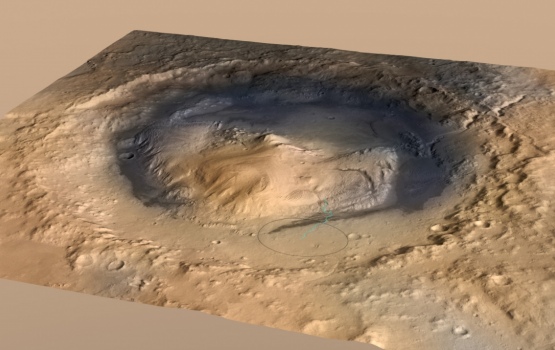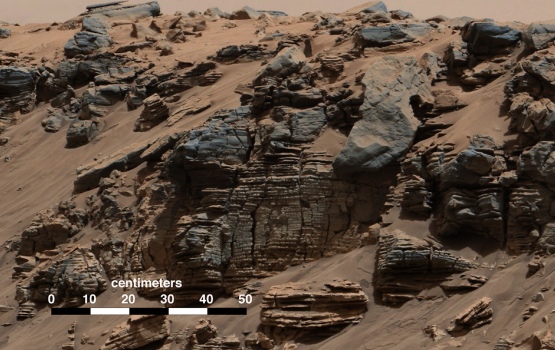

Curiosity rover reveals the role played by large lakes in forming Martian mountain.
In 2012, NASA landed a robotic vehicle called Curiosity on Mars, in a crater 96 miles in diameter, dubbed Gale Crater. The vehicle has since been driving around and gathering data that is helping researchers to learn more about Mars’ past habitability.

The NASA researchers, including Professor Sanjeev Gupta from Imperial College London, are currently using Curiosity to investigate a particular set of sedimentary rocks called the Murray formation at the base of Mount Sharp, which stands about 3 miles high in the centre of Gale Crater. These sedimentary rocks show alternating sand and silt deposits delivered by lakes, rivers and wind. The sedimentation pattern suggests that the lakes came and went repeatedly, building the base of Mount Sharp in the process.
The team’s working interpretation of their analysis is that ancient Mars sustained a climate that could have produced lakes in many locations that were much larger and longer-lasting than any previously confirmed.
The findings suggest that environmental conditions may have been favourable for microbial life even during the intervals when water was not standing on the surface, but could persist just beneath it.
Professor Gupta said: “Mars was once a world similar to Earth, with its own lakes and rivers. The rocky records we are studying at the base of Mount Sharp shows that Gale Crater sustained much larger bodies of water for much longer periods of time than we previously thought. We are seeing that the base of Mount Sharp was formed from successive layers of sediment deposited by water over millions of years.
“This evidence points to a world that was warm enough to sustain water on the surface for much longer periods of time than we previously thought. Tantalisingly, these large bodies of water may have provided the perfect conditions for microbial life to gain a foothold, even during the dry periods, when they may have retreated below the surface.”
Despite earlier evidence from several Mars missions pointing to wet environments on the planet, the modelling of Mars’ ancient climate has yet to identify the conditions that could have produced long periods warm enough for stable water on the surface.
Ashwin Vasavada, Curiosity Deputy Project Scientist at NASA's Jet Propulsion Laboratory, said: "If our hypothesis for Mount Sharp holds up, it challenges the notion that warm and wet conditions were transient, local, or only underground. The better explanation is that Mars' ancient, thicker atmosphere raised temperatures above freezing globally, but so far we don't know how the atmosphere did that."
John Grotzinger, Curiosity Project Scientist from the California Institute of Technology, said: "We are making headway in solving the mystery of Mount Sharp. Where there's now a mountain there may have once been a series of lakes. The great thing about a lake that occurs repeatedly, over and over, is that each time it comes back it is another experiment to tell you how the environment works. As Curiosity climbs higher on Mount Sharp, we will have a series of experiments to show patterns in how the atmosphere and the water and the sediments interact. We may see how the chemistry changed in the lakes over time. This is a hypothesis supported by what we have observed so far, providing a framework for testing in the coming year.”
NASA's Mars Science Laboratory Project is using Curiosity to assess ancient habitable environments and major changes in Martian environmental conditions. The project is one element of NASA's ongoing and future Mars missions preparing for a human mission to the planet in the 2030s. JPL, a division of the California Institute of Technology, built the rover and manages the project for NASA's Science Mission Directorate in Washington.
This story is adapted from a NASA news release.
Article text (excluding photos or graphics) available under an Attribution-NonCommercial-ShareAlike Creative Commons license.
Photos and graphics subject to third party copyright used with permission or © Imperial College London.
Reporter
Colin Smith
Communications and Public Affairs

Contact details
Email: press.office@imperial.ac.uk
Show all stories by this author











Leave a comment
Your comment may be published, displaying your name as you provide it, unless you request otherwise. Your contact details will never be published.